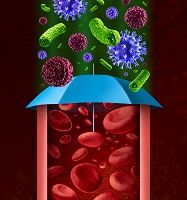Article
Patients with Psoriatic Arthritis Treated with Biologics Have Higher Infection Rates
Author(s):
New analysis of data from longitudinal cohorts finds that psoriatic arthritis patients were more than 50% more likely than those with psoriasis but no arthritis to develop infection. It also provides further evidence that biologic medications are also a risk factor for infection.

New analysis of data from longitudinal cohorts finds that psoriatic arthritis patients were more than 50% more likely than those with psoriasis but no arthritis to develop infection. It also provides further evidence that biologic medications are also a risk factor for infection.
Records showed 498 infections among the 695 patients in the psoriatic arthritis cohort and 74 infections among the 509 patients in the psoriasis-only cohort. Investigators fitted an exponential model to calculate that the incident rate for infections was 19.6 per 100 person-years in the former cohort and 12.2 per 100 person-years in the latter. They then fitted a Weibull regression model to calculate that the hazard ratio (HR) of the time to first infection in the psoriatic arthritis cohort versus the psoriasis-only cohort was 1.6 (p=0.002).
Further analysis of patient records found that treatment with biologic medications was also associated with a greater risk of infection in both cohorts. The HR for time to first infection among psoriatic arthritis patients who used biologics was 1.56 that of patients who used other medications (95% confidence interval [CI], 1.22 to 2.00). The HR for time to first infection among psoriasis-only patients who used biologics was 1.50 (95% CI, 0.64 to 3.54).
In the psoriatic arthritis cohort, women were significantly morel likely than men to develop infections. In the psoriasis-only cohort, a lower Psoriasis Area and Severity Index score and a higher Functional Comorbidity Index were associated with a greater risk of infection.
Ultraviolet treatment, on the other hand, was significantly associated with lower rates of infection in both cohorts.
There were no infection-related deaths in either cohort, and there were no significant differences in hospitalization rates between the psoriatic arthritis patients and the psoriasis patients.
“The data confirm the association between infection and biologic treatment in psoriatic disease,” the study authors wrote in The Journal of Rheumatology.
Biologic drugs work by blocking the inflammatory components of the immune system, mostly tumor necrosis factor-alpha (TNF-alpha). This immunosuppressant effect eases the symptoms of rheumatic diseases but also reduces the body’s defense against attack.
The new study did not distinguish among different biological treatments, but previous research indicates that different medications are associated with different degrees of risk.
A 2015 study that appeared in JAMA Dermatology compared infection rates associated with biologic and non-biologic treatments in 11,466 psoriasis patients. The cumulative incidence rate of serious infections per 100 patient years was 0.83 among ustekinumab users, 1.05 among patients who used neither methotrexate nor biologics, 1.28 among patients who used methotrexate but no biologics, 1.47 among etanercept users, 1.97 among adalimumab users, and 2.49 among infliximab users.
“Results suggest a higher risk of serious infections with adalimumab and infliximab compared with nonmethotrexate and nonbiologic therapies,” the authors of that study wrote. “No increased risk was observed with ustekinumab or etanercept.”
A 2013 study that appeared in the Journal of Translational Medicine found that regimens that combined TNF-alpha inhibitors and corticosteroids were associated with particularly high levels of infection in patients with rheumatic diseases. The infection rate per 100 patient years was 62.7 among patients who used such combinations but only 12.4 among patients who used corticosteroids and disease-modifying anti-rheumatic drugs.





